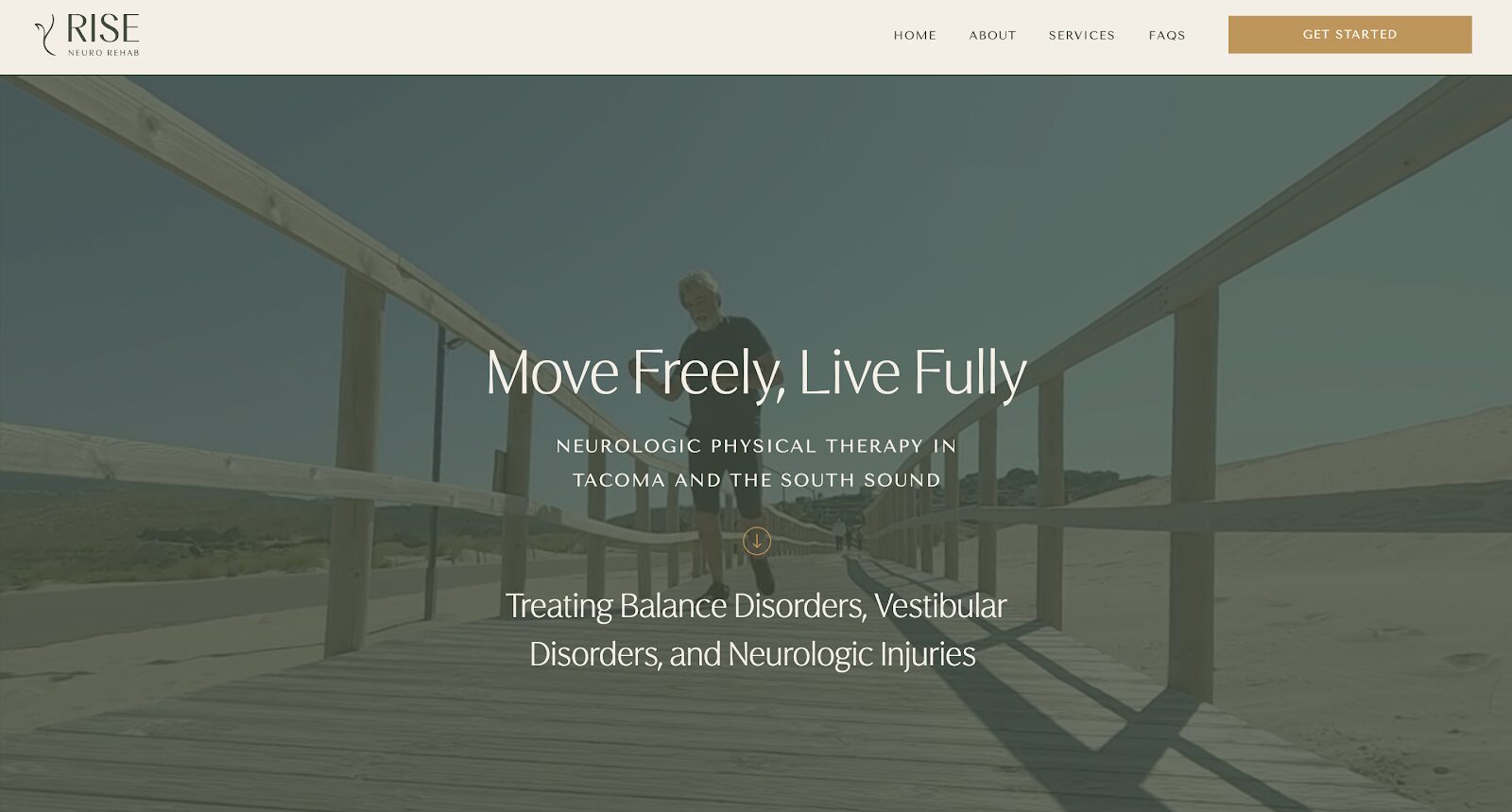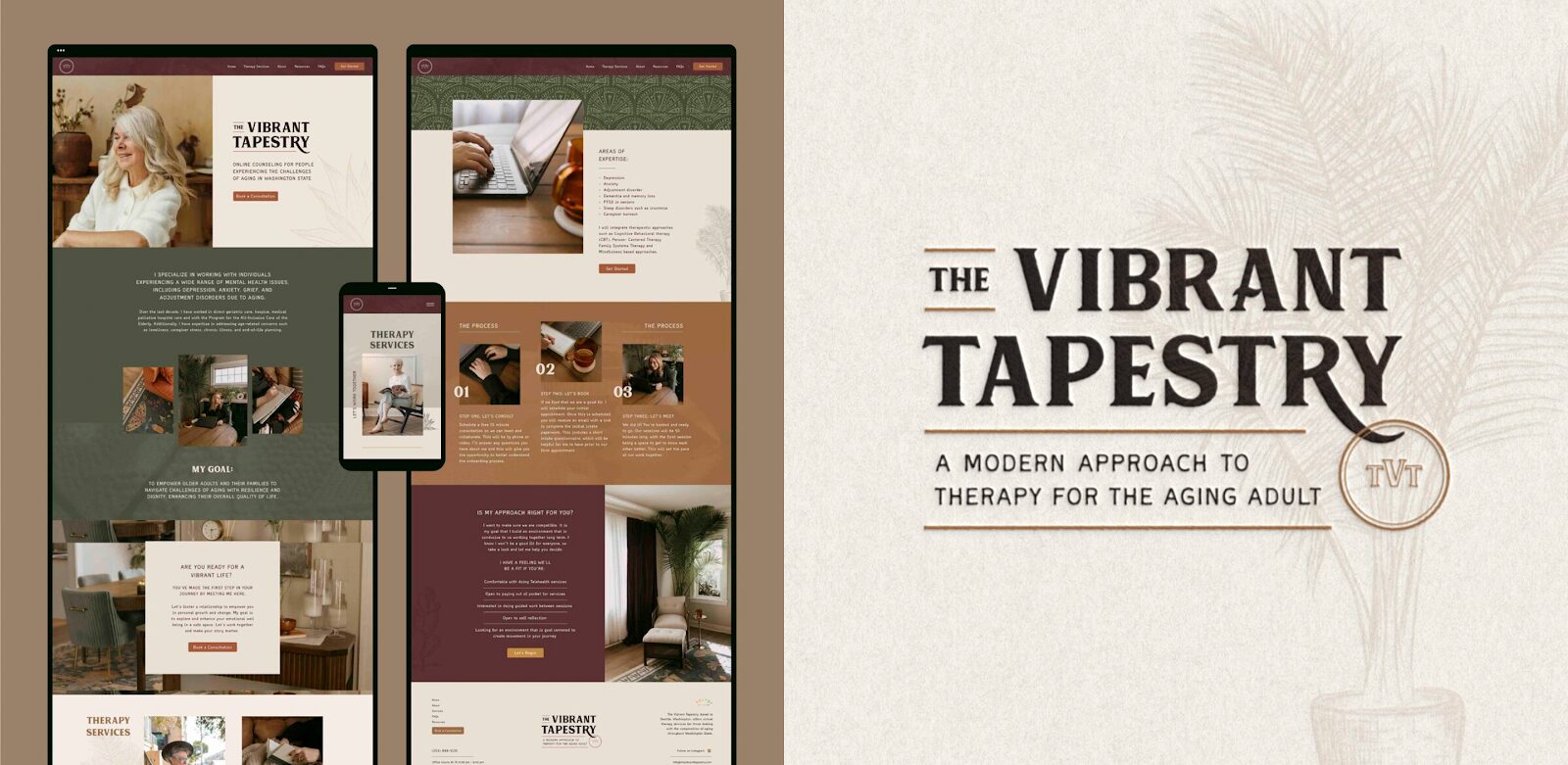How to Open Your Own Therapy Practice for More Freedom
April 7, 2025
Wondering how to open your own therapy practice? As a brand designer who often works with therapists, I’ve witnessed the joy that comes with creating a practice that’s entirely yours – where you have the freedom to set your schedule and work with aligned clients.
Of course, that excitement also comes paired with overwhelm. Grad school didn’t exactly teach you the business side of therapy, and between legal requirements, office space, systems, and marketing, the mountain can seem too steep to climb.
This is why I focus on helping therapists position their practices in specific and intentional ways. When your brand clearly communicates who you are and who you serve, you attract the right clients and avoid the burnout that claims many practitioners who try to be everything to everyone.
So, here’s how to open your own therapy practice. I’ll cover the 7 steps you should take, with a particular focus on marketing and positioning your new business.
Why You Should Consider Becoming a Private Practice Owner
The way I see it, the biggest benefit to running your own practice is the autonomy:
- You gain the agency to make every decision about your clinical work.
- You choose which therapeutic modalities to focus on and which clients you’re uniquely equipped to help.
- You decide whether accepting insurance makes sense for your practice or if you prefer a private-pay model.
- You set your hours based on when you do your best work, not when an agency tells you to be available.
Small freedoms add up, too. You can step out for a coffee break or enjoy midday yoga whenever you want to, because why not? Of course, you still have to see clients and do administrative tasks, but you’re the one managing your calendar. You’re your own boss!
But the most meaningful benefit is this: When your practice authentically reflects your strengths, you naturally attract clients who respond to your specific approach. This alignment means that you can help your clients in more impactful ways.
Learn more about becoming a creative entrepreneur.
How to Open Your Own Therapy Practice in 7 Steps

1. Do a Braindump
Starting your own practice can feel like standing at the base of a mountain without a map. So, the first step is: get everything out of your head and onto paper.
Grab a notebook or open a document and list every single thing you need to address. Don’t worry about organizing it yet, just dump it all out.
This mental clearing will help make planning your private counseling practice less overwhelming. Your braindump might include:
- Legal requirements (licenses, business structure, insurance)
- Financial considerations (startup costs, fee structure, banking)
- Location decisions (physical office, virtual, hybrid)
- Technology needs (scheduling systems, payment processing)
- Marketing essentials (website, social media, networking)
- Client experience elements (intake forms, policies, communication)
- Personal boundaries (work hours, client types, vacation time)
Once everything is visible, you can prioritize and tackle each area methodically.
2. Figure Out Your Positioning
This is where many therapists stumble, but I believe that figuring out how to position your private practice is the foundation that everything else builds upon.
I’m not talking just about picking a specialty. Although that IS important, it runs deeper than that. Ask yourself positioning questions like:
- What kind of therapist am I when I’m at my best?
- Which clients light me up and which drain my energy?
- What unique combination of training, personality, and approach do I bring?
- How do I want clients to feel when working with me?
- What problems am I uniquely equipped to help solve?
Narrowing your focus might feel like you’re limiting your opportunities, but it works the opposite way.
When you speak directly to a defined audience, they feel seen in a way that generic messaging could never achieve.
For example, instead of “I work with anxiety,” you might position yourself as “I help high-achieving professionals who appear successful on the outside but are privately overwhelmed by perfectionism and anxiety.” That specificity makes your target audience feel more connected to you.
3. Create a Business Plan
You don’t need a long and complicated business plan, it just needs to be clear and reflective of your goals. Consider including:
- Vision Statement: Where you’re headed and why it matters (ex, I’m building my own private practice serving new mothers navigating postpartum identity shifts, helping them rediscover themselves while building bonds with their babies).
- Services: What you’ll offer, such as individual therapy, couples work, groups, workshops, digital products, etc.
- Financial Projections: Basic numbers to guide your decisions, such as how many clients you need to meet your income goals, your fee structure, and anticipated monthly expenses.
- Marketing Plan: How clients will find you.
- Success Metrics: How you’ll measure progress. This can be anything that matters to YOU – income benchmarks, work/life balance, etc.
You’ll revise your business plan as your solo practice grows and serves more clients, so this first draft doesn’t need to be perfect. You just need to start.
SBA (Small Business Administration) has handy business plan templates you can use!
4. Take Care of the Legal Requirements and Logistics
This is the nuts-and-bolts stage. It’s less exciting than therapist branding, perhaps, but essential for building a legitimate and sustainable practice. Here are two checklists for you to get started, but it’s also a great idea to consult with an attorney in your area!
Legal Setup Checklist:
- Choose a business structure (sole proprietorship, LLC, or corporation)
- Register your business name (and check trademark availability)
- Obtain business licenses (state and local)
- Apply for an Employer Identification Number (EIN)
- Secure professional liability insurance and/or malpractice insurance
- Establish HIPAA-compliant procedures and documentation
- Create informed consent and practice policies
- Apply for a National Provider Identifier Number if accepting insurance
- Register for state and local taxes
- Check your local zoning laws
Logistics Checklist:
- Open a dedicated business bank account
- Set up a payment processing system
- Choose practice management software for scheduling and documentation
- Decide if you’re going to need an office or if you’ll do virtual therapy only
- Create a professional email address
- Establish a phone system (will likely need to be HIPAA-compliant, too)
- Set up secure document storage
- Connect with other therapists to refer clients to each other
Many private practitioners consult a lawyer or another relevant professional when it comes to matters like their professional liability insurance coverage and HIPAA compliance to protect client privacy.
5. Create a Website
Your website is often the first impression potential clients have of you, and it works for you 24/7, even when you’re sleeping or in session. A professional therapy website builds credibility and showcases your unique positioning, making it a no-brainer for prospective clients to inquire.
Plus, with smart SEO (Search Engine Optimization), your website comes up in Google searches when people are looking for help with relevant issues. Learn more about SEO for therapists!
When it comes to creating your website, you essentially have two main options: build it yourself with a template or work with a professional designer (like me, hi!).
Website platforms often have pre-made designs that you can adapt to your needs. This approach typically costs between $100 and $500 for the template itself, plus your time.
You’ll select a design that resonates with your vision and then customize the colors, images, and content to match your brand identity. However, most of the time, the final result falls short of the professional look you envisioned. Not to mention the time commitment, which can be substantial.
This is why I typically recommend therapists entering private practice to get a professional website. This way, you can get a custom + beautiful design with therapy-specific necessities like secure contact forms.
Learn more about my design services or check out my portfolio!
6. Learn to Market Yourself
For many therapists, marketing feels uncomfortable at first. After all, your training focused on helping others, not promoting yourself. So, if you feel anxious about marketing your new practice, that’s normal!
To be honest, as a small business owner myself, I can relate to that feeling. A huge mindset shift that I had to make is to stop viewing selling as a bad thing, and instead start recognizing it for what it is: a way to connect with people who need my skills and expertise. It’s a way to help.
Luckily, there are many marketing channels to choose from, and these are some particularly impactful ones for therapists:
- Search Engine Optimization (SEO): Perfect for introverts who prefer working behind the scenes. When you optimize your website with relevant keywords, you attract clients who’re already looking for your services. This takes time, but it can work really well for some private practice therapists.
- Social Media: Choose 1-2 platforms where your target audience spends a lot of time, and focus on providing genuine value and having real conversations with people.
- Professional Networking: Connect with complementary providers like doctors, psychiatrists, nutritionists, or coaches who might refer clients your way.
The most important thing when it comes to marketing efforts is to stay consistent! It’s MUCH better to know one platform inside and out than to sporadically (try to) show up across many.
Learn more about marketing for therapists.
7. Grow As You Go
The best (and maybe also the worst) part about owning your own business? You’ll never stop learning, and you’ll never have it fully figured out. There’ll ALWAYS be the next big goal to go after.
Sometimes, it can make you feel like you’re falling behind, but the truth is that even the most successful private practices don’t have it all figured out. Moreover, every established practice owner started exactly where you are now.
You’re taking a brave step, and bravery pays off. You don’t have to be perfect to be successful, and the most important thing is to lean into your unique positioning and brand because there’s no one like you.
Which brings me to my next point!
Building Your Business Owner Mindset
When you work for an agency or group practice, you operate within established systems. Someone else handles the big decisions, manages the finances, and determines the policies. Your focus stays primarily on clinical work.
But when you launch your private practice, suddenly every aspect of the business falls to you. This transition can trigger unexpected emotional responses, like self-doubt and perfectionism.
Owning a therapy practice means embracing your authority to shape every aspect of your professional life. You’re still a therapist, but you’re also now a decision-maker and a boundary-creator.
You’ll need to learn how to set your fees without apologizing, confidently explain your policies to new clients, make decisions about your schedule based on what serves you best, and say no to opportunities that don’t align with your vision. This can feel both scary and amazing!
How to Reach Your Private Practice Goals
It can be really tempting to try to do EVERYTHING. You may want to immediately implement every new marketing strategy you read about or create content for multiple social media channels.
But a much better strategy (for both starting a private practice and your mental health!) is to become deeply rooted in your specific positioning and build methodically from that foundation.
When you know what truly matters to you and what sets you apart, you can make focused decisions that speak to your unique strengths and goals.
This is why the branding process for therapists is so important. When you work with me, I help you figure out how to position your private practice and visually express it through your logo, colors, and website.
Private Practice Examples to Get Inspired
Sequoia Therapy Group

A private therapy practice in Columbus, Ohio, Sequoia Therapy Group wanted their online presence to feel warm, earthy, and welcoming.
This brand didn’t have a niched down target audience – they work with individuals, couples, and families – but they wanted to attract people who specifically needed support overcoming challenging life experiences, whether it’s first responders dealing with difficulties on the job or mothers experiencing perinatal challenges.
Rise Neuro Rehab

Dr. Amy Luong, the physical therapist behind Rise Neuro Rehab, provides physical therapy in Tacoma and the South Sound. Her mission is to empower people to rise above physical limitations and take back control of their lives during recovery after a neurological injury.
On Rise Neuro Rehab’s website, we emphasized the importance of individualized, patient-centered care that’s not dictated or limited by insurance.
The Vibrant Tapestry

My client, The Vibrant Tapestry, has a very specific focus: Renee is an online therapist for aging adults in Washington state. She helps her clients honor their unique stories, perspectives, and complexities as they grow older.
I designed her brand and website to communicate warmth, acceptance, and peace to speak to this target audience.
All of the websites above have HIPAA-compliance features like custom-coded Google Forms or Microsoft 365 for getting in touch.
They’re also built on Showit, which is the platform that I believe to be the best website builder for therapists!
Branding & Website Design for Therapy Practice Owners
When you’re opening your own therapy practice, there’s a lot to figure out. Some of these things are very exciting (looking at you, new office furniture) and others, like needing to pay for your own health insurance if you go full-time…well, not so much.
Figuring out how to position your private practice early on can make a huge difference. It gives you clarity and an edge. If you want to learn more about how I can help you build your brand identity and private practice website, see my services!
About the Author:
Rose Benedict
Owner and Designer, Rose Benedict Design
Rose Benedict is a brand and website designer for therapists, creatives, artists, and service providers. Rose is also a Showit Design Partner and the owner/designer at Rose Benedict Design. She has been a designer for the past 10 years and has worked at a Fortune 15 company and top university in Columbus, Ohio. She brings both her brand/website design and technical experience to small business owners so that they can thrive and deeply connect with their ideal clients. Outside of work, Rose loves reading, pilates, gardening, and traveling (10 countries and counting!).
Rose Benedict Design is a brand and Showit web designer based in Columbus, Ohio, devoted to crafting beautiful, strategic brands for creatives and service providers.
©2022-2024 ROSE BENEDICT DESIGN
Rose Benedict Design is a proud Showit Design Partner.